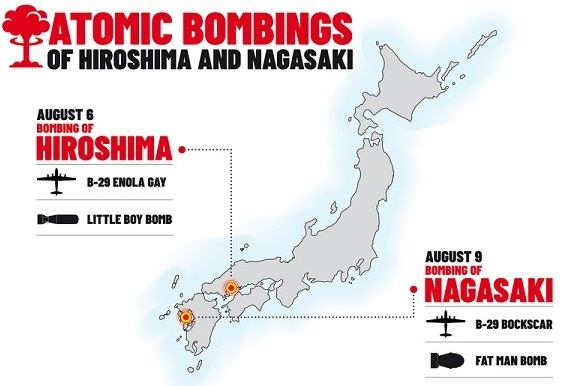

On August 6 and 9, 1945, consecutively, the United States deployed two atomic weapons over the Japanese cities of Nagasaki and Hiroshima. The two strikes are the first nuclear missile to be used in a military confrontation to date, killing about 129,000 and 226,000 people, the majority among them being citizens.
The Allies planned for an expensive assault on Japanese territory in the concluding year of the Second World War. A standard and setting off bombs operation that demolished 64 Japanese cities. When Germany fell on May 8, 1945, the conflict within the European battlefield had come to an end, and the Allies quickly concentrated on the War In the pacific. The Manhattan Program of the Allied group had constructed two distinct types of nuclear arms by July 1945: “Fat Man,” a nuclear warhead of a plutonium collapse variety, and “Little Boy,” a nuclear missile enriched with uranium.
The Allies destroyed Germany in May 1945 before the nuclear bomb was ready. Nevertheless, the war with Japan dragged on, and it was thought that an assault on Japan was essential to convince the Japanese to submit. On August 6, 1945, the first atomic bomb exploded in Hiroshima city by a bomber, an American B-29. With an approximate force of 12,500 tonnes of TNT, the weapon blasted into the city. About 140,000 people were either killed immediately or suffered radiation sickness or died from other causes within some months of the Hiroshima bombing.
After the bombing of Hiroshima, Truman once more asked for the Japanese government to accept their surrender, but Japan declined. The United States exploded a second bomb in Nagasaki city of Japan on August 9. Nearly 80,000 people perished. The two nuclear detonations ultimately result in the death of 210,000 civilians. The Japanese union cabinet approved a surrender term when the Soviet Union commenced war against Japan. Then the Second World War ended.

The hidden US administration scientific and technological programme that developed the first nuclear explosives at the time of the 2nd World War was the Manhattan Project. The US president was warned by Einstein about Nazi Germany's initiation of working on developing a nuclear missile. The Manhattan Project had launched in August 1942. The Private businesses of DuPont contributed to manufacturing the weapon systems like uranium and some other ingredients needed to construct the bombs. The first nuclear bomb was fired off on July 16, 1945, at an army testing site in Alamogordo, New Mexico.
To save the maximum number of American people, the U.S. intended to force the Japanese to fast surrender. In contrast, it was privately determined that the Soviet Union would participate in the conflict against Japan at the Yalta Summit. The use of the atomic bomb was supposed to guarantee American leadership in the world after the war. The US sought to deploy its first atomic warhead in a constant conflict to judge its efficiency.
Most of the towns in Japan were already abolished, and Hiroshima became an easy target for them due to their city's layout and size, which made it a decent test venue for checking the bomb's devastating power. The decision was also made because of the city's intensity of military and war materials facilities.
Nagasaki was not an initial aim. Despite torpedoes and other weapons being developed there, Nagasaki's mountainous hills and proximity to an Allied prisoner-of-war camp proved it less appealing. On August 9, 1945, the B-29 attacker Bockscar en route to its second strike of Nagasaki when switched from its original target of Kokura due to dense clouds and smoke. According to the US, the attacks accelerated Japan's capitulation and avoided the necessity for an invasion by the US.
Hiroshima and Nagasaki served as a trial run for a new conflict, the repercussions of which weren't fully comprehended at that time. Those two cities have been demolished in August 1945, putting a conclusion to World War II but with a tremendous expense to unfortunate Japanese residents. This tragedy undoubtedly marked the beginning of the nuclear age.
During World War II, strikes on the Japanese city areas of Hiroshima on August 6, 1945, and Nagasaki on August 9, 1945, signified the debut of nuclear explosives in military combat. The initial bombings claimed the lives of many people, while many more would eventually die from radiation sickness. The Manhattan Project gave rise to the bombs. The B-29 bomber Enola Gay flew off from Tinian on August 6, 1945, and destroyed Hiroshima with a uranium cannon assembly. Approximately 70,000 people died quickly, and thousands more died from radiation sickness a year later. The B-29 Bockscar stayed over Kokura which was its original target, but the bombardier was incapable of detecting his aim point because of the thick cloud cover. Then, Bockscar continued to Nagasaki and dropped a plutonium implosion explosive that instantaneously killed 40,000 people on August 9, 1945. These two blasts finally ended World War II.
Q1. How big of a blast did Hiroshima have?
Ans. The bomb exploded in the Japanese town of Hiroshima on August 6, 1945. A B-29 dropped the explosive and destroyed it from about 31,000 feet (ca. 9 km). The bomb blasted 1,500 feet (0.46 km) through the city with a force of 15,000 tonnes of TNT.
Q2. What impact did the bombing of Hiroshima have on the economy?
Ans. It evaluated the loss to be 884,100,000 yen (as of August 1945). Since Japan's income per capita was 1,044 yen, this quantity was equal to the annual salary of 850,000 ordinary Japanese people during that period.
Q3. What is the impact of Hiroshima on human rights?
Ans. The Hiroshima healthcare human rights topic, which influenced several countries, resulted in the creation of the international agreement on individual rights. Unquestionably, the Hiroshima bombing introduced Japan's issue of poor medical services concerning human rights.